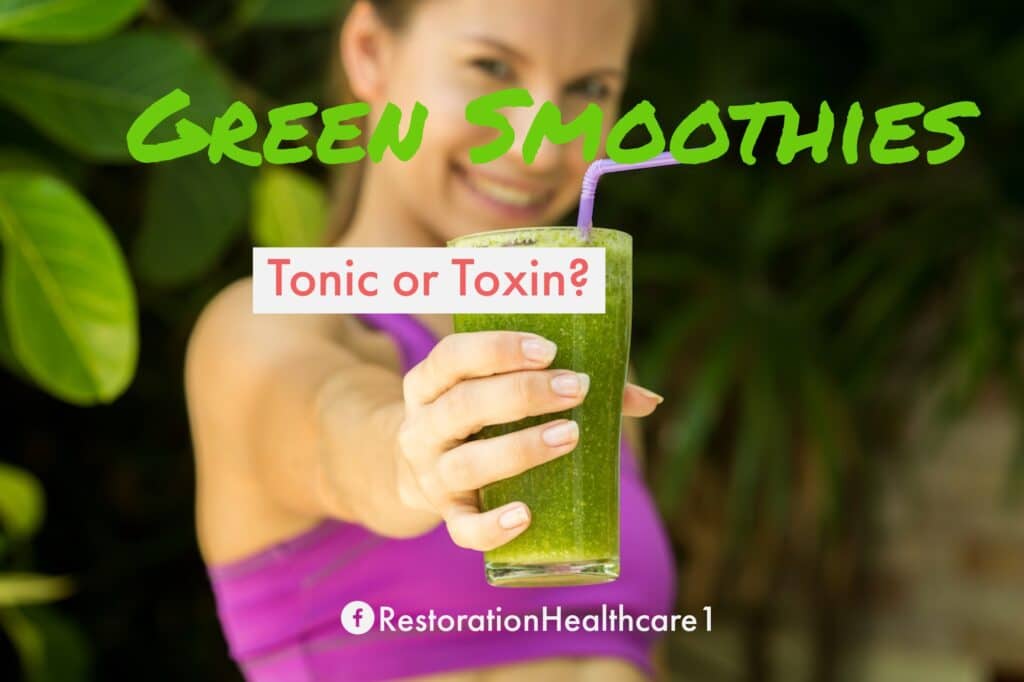The Green Smoothie: Tonic or Toxin?

Imagine filling your cup at the fountain of youth. No one would blame you if you envision a green smoothie — a frothy concoction of all-natural nutrients certain to restore your youthful energy and appearance.
So what’s with the headline here? How could a green smoothie possibly be toxic?
The concern swirls around organic chemical compounds that tend to be found in many of the ingredients used in green smoothies — oxalates.
What are oxalates?
Oxalates are crystalline molecules absorbed in the diet and produced by yeasts and fungi in the body. They are best known when they accumulate to the point of forming jagged kidney stones that are difficult and painful to pass through the urine. However, oxalates can also accumulate in other bodily tissues, causing inflammation, irritation, and pain. If you have kidney stones, vulvodynia (vulvar pain), or fibromyalgia, oxalates may be a contributing factor. Children with autism who poke at their eyes are often found to have an increased concentration of oxalates behind their eyes. (See “The Dangers of Oxalates and the Green Smoothie Health Fad.“)
What causes oxalate buildup?
Oxalate buildup in the body can be traced to these three contributing factors:
- Diet: A diet high in oxalates can overwhelm the body’s ability to eliminate them. Foods high in oxalates include spinach, beets (including the greens), purslane, Swiss chard, soy, nuts, and berries. Spinach is one of the worst, but many plant-based foods have high levels of oxalates.
- Yeast/fungal overgrowth: Candida yeast and other yeasts and fungi can trigger a series of chemical reactions that convert sugars into oxalates.
- Poor oxalate metabolism: Some people are ill-equipped biologically to eliminate oxalates from their bodies. One in every 100,000 to one million people has a genetic disease, known as primary hyperoxaluria, in which the liver produces too much oxalate.
Why single out green smoothies?
Although oxalates are a problem regardless of how you prepare oxalate-rich foods, green smoothies compound the problem in three ways:
- Ingredients in green smoothies tend to be oxalate-rich. The green often comes from spinach, kale, Swiss chard, arugula, or purslane, all high in oxalates. Many green-smoothie recipes also call for berries and nuts, which are also high in oxalates.
- A smoothie increases the quantity consumed. While you might add a handful of spinach to a salad, for example, it is not uncommon to add two cups of packed down spinach leaves to a blender to create a green smoothie. (This is similar to the problem of drinking a glass of orange juice rather than simply eating an orange.)
- Blending releases oxalates. Just as blending releases nutrients, it releases oxalates, making them easier for the body to absorb.
What should I do?
Oxalates may or may not be a problem for you, depending on your body, diet, and lifestyle. However, if you have a condition that may be related to high levels of oxalates or you are concerned about developing such a condition, consider the following:
- Get your oxalate levels tested. The only way to tell whether you have high levels of oxalates is to test for them. An Organic Acids Test (OAT) has three oxalate markers: glyceric, glycolic, and oxalic acids. Low B6 and increased yeast or fungal levels may also indicate elevated oxalate levels.
- Get gene-tested for oxalate metabolism. Tests can be run to identify any genetic predisposition to problems associated with your body’s production or elimination of oxalates.
- Restore (if necessary) and maintain healthy gut flora. Treat any Candida yeast or other yeast or fungal overgrowth immediately to prevent these organisms from contributing to high oxalate levels.
- Consume a low-oxalate diet. Avoid oxalate-rich foods, such as leafy greens, nuts, berries, beans, soy, wheat germ, chocolate, and tea.
- Consult your healthcare provider about taking calcium citrate and magnesium citrate. Increased oxalate levels can deplete levels of calcium and magnesium. Supplements may be required to restore levels and to reduce oxalate absorption from the intestine. People with elevated levels of oxalates may suffer from week bones and teeth, because the body uses calcium and magnesium to neutralize the oxalic acid.
- Consider supplementing with chondroitin sulfate. Chondroitin prevents the formation of calcium oxalate crystals.
- Consider supplementing with vitamin B6. Vitamin B6 is a cofactor of one of the enzymes that reduces oxalate production and breaks down oxalate in the body.
- Increase your water intake. Water improves the elimination of oxalates in the urine and feces.
The overall approach is a two-pronged attack: 1) reduce the amount of oxalates entering your body and 2) give your body what it needs to eliminate the oxalates already in your system.


